Photos with this report (click to enlarge) | |||
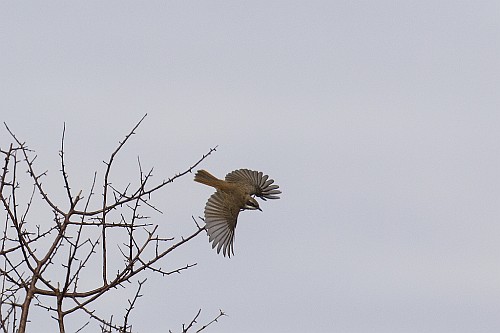 Herero Chat |
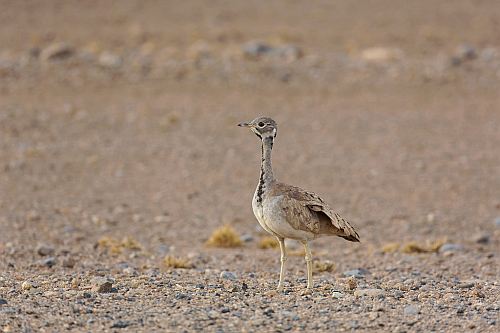 Rupple's Korhaan |
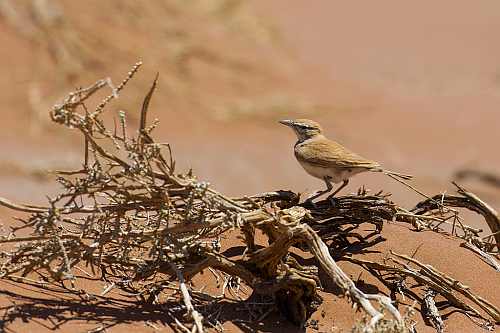 Dune Lark |
|
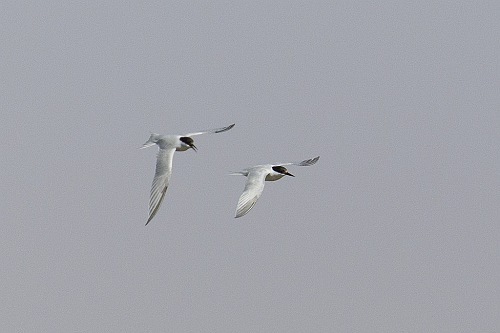 Damara Tern |
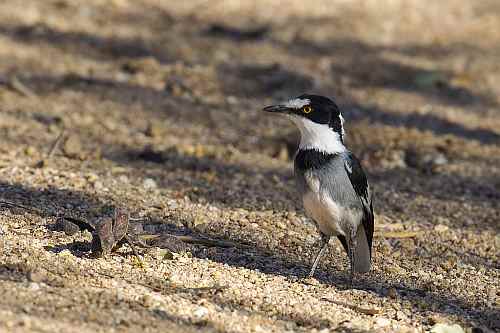 White-tailed Shrike |
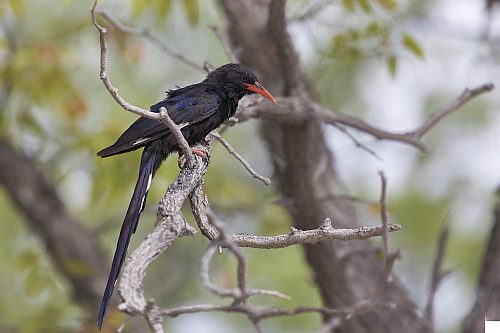 Violet Wood-Hoopoe |
|
Tour Participants: Larry Derr & Alan Shears
Tour leaders: Leon Marais
Temperature Range: 17 – 38 °C
Total Birds Seen: 202
Total Mammals Seen: 30
Birds of the Trip: Augur Buzzard, Rüppel’s Korhaan, Damara Tern, Violet Wood Hoopoe, Damara Red-billed Hornbill, Montiero’s Hornbill, Rüppel’s Parrot, White-tailed Shrike, Carp’s Tit, Gray’s Lark, Dune Lark, Damara Rockrunner, Bare-cheeked Babbler, Black-faced Babbler, Herero Chat, (denoted by shaded cells in the bird list).
Trip Report Compiled By: Leon Marais
Notes:
This was another great Namibian tour run by Lawson’s. As with much of Southern Africa, Namibia is in the grip of a drought, and this did have an effect on the birding, with certain usually common species just not making an appearance, and the usually present Hartlaub’s Spurfowls of Erongo having disappeared completely, it seems. Still, it was a wonderful experience, with great overall birding, good wildlife and stunning scenery throughout. And indeed, that really captures the spirit of birding in Namibia – great birding which takes place in some of the most impressive scenery you’ll ever see. The accommodation comprised Namibian Wildlife Resorts chalets, private lodges and a guest house in Swakopmund. The food was good overall, and included a few packed meals to allow us to maximize our time in the field. The vehicle was a Toyota Fortuner 4x4, which fit the bill perfectly and was comfortable, even on some of the longer road journeys. Thanks to Larry and Alan for joining this tour and it was from our side a pleasure to host you here in Southern Africa. See details for the 2020 trip here: Essential Namibia Birding 2020
Trip Breakdown
Day 1: Saturday, 16th November 2019 ~ Windhoek
Today was an assembly day – Larry had arrived late the night before due to flight delays, and Alan arrived late as well today due to flight delays, so there wasn’t much time for birding, though Larry and I did a bit of birding in the resort grounds, recording species such as Chestnut-vented Warbler, Southern Masked and Lesser Masked Weavers, White-backed Mousebird, Dusky Sunbird and Rosy-faced Lovebird. By the time Alan was checked in we had a bit of time to unwind before dinner and an introduction to the tour to come.
Route: N/A
Weather: Clear and hot
Bird species seen: 12
Bird of the day: Rosy-faced Lovebird.
Day 2: Sunday, 17th November 2019 ~ Sesriem
Today we left Windhoek at the early hour of 05h15, the mission at hand being a Herero Chat stakeout on the Spreetshoogte Pass, where the central highlands give way rather suddenly to the vastness of the Namib Desert, one of the scenic highlights of the tour. We left Windhoek in the dark, heading south via Rehoboth, then taking the C24 and D1265 south-westwards. We arrived on the pass at 08h00 under relatively cool conditions, and proceeded half way down to begin the search for the Herero Chat. We started off walking slowly and checking out suitable spots until we had reached the last bend near the bottom of the pass, and then proceeded to the bottom by car where we turned around and headed back up for a second go. On the way up we spotted a single Herero Chat perched up on top of a tree close to the road, and got fairly brief but cracking views before it flew off. We then followed it back down the pass for more views, seeing a second bird as well, and getting some more prolonged views. This was a great start, as Herero Chat is arguably one of the more difficult Namibian specials to find, and this took a lot of pressure off for later in the tour. On the way back up again we also saw a pair of Verreauxs’ Eagles in display flight, and had a close fly-over by an Augur Buzzard. We then had a picnic breakfast, during which we had quite a number of White-backed and Lappet-faced Vultures swirling overhead. We then made our way to camp via Solitaire, where we had a quick break, with fantastic scenery all the way to our lodge in the Namib Naukluft National park at Sesriem. We checked in and had a break and then took a short afternoon drive that produced a great sighting of a pair of Rüppel’s Korhaans, with some great audio as they advertised their territory as the day came to an end. Back at the lodge we had dinner on the deck, with stupendous views of the sun setting to the west, before calling it a night in anticipation of a great day to come
Route: Windhoek to Sesriem via Rehoboth, the Spreetshoogte Pass and Solitiaire
Weather: clear and hot
Bird species seen: 45
Birds of the day: Herero Chat, Augur Buzzard, Verreauxs’ Eagle.
Day 3: Monday, 18th November 2019 ~ Sesriem and Solitaire
Today we left camp at 06h00 heading into the park, destined for Sossusvlei and the huge dunes of the Namib sand sea – one of the classic scenic spots of Namibia. En-route we got a beautiful trio of Rüppel’s Korhaans, making for a great start to the day. From there we proceeded slowly to the Tsauchab River view site, where we began the search for Dune Lark, Namibia’s only true endemic and an important bird on the tour. Surprisingly though we could not locate one, this spot usually being a solid bet. After a while of searching (with another birding group also coming up empty-handed) we decided to push on, seeing a lovely Ludwig’s Bustard before making for our breakfast spot at Sossusvlei, with some stops along the route to admire the incredible desert scenery all around us. At the Sossusvlei picnic site we ate among the resident Cape Sparrows, and afterwards Alan took a walk into Deadvlei for some landscape shots while Larry and I searched the Picnic area for the resident Spotted Eagle Owl pair. We found them roosting in a large Camel Thorn tree, and it seemed as if the female might have been on a nest. From there we collected Alan from his walk to Deadvlei, showed him the owls and then made our way back to the Dune Lark spot, where we were soon rewarded with great views of one only a few minutes after arriving. We then headed back to the camp to relax, and in the late afternoon headed out again, hoping to find the Dune Lark again in better light. But once again it did not oblige, but we still had a great time photographing Oryx, Springbok, some birds and the curious Fairy Circles of the Namib Desert before heading back for dinner.
Route: Sesriem to Sossusvlei
Weather: clear and warm
Bird species seen: 24
Birds of the day: Dune Lark, Ludwig’s Bustard, Spotted Eagle Owl.
Day 4: Tuesday, 19th November 2019 ~ Swakopmund
Today we met up for breakfast at 07h00 overlooking the desert, then packed up and departed for the coast, stopping to see Sesriem Canyon not far from the lodge on the way out. This interesting slot canyon owes its origins to the ice age, and makes for a good spot to search for Bradfield’s Swifts, which unfortunately weren’t present during our short visit. It was more a travelling day, albeit through some spectacular scenery, with several stops to take photographs and to try and soak it all in. We picked up some lunch to go in Solataire and took a few scenery stops on the way, arriving in Walvis Bay in the mid-afternoon. The tide in the bay was low and the exposed mud flats were crammed with both Greater and Lesser Flamingos, making for a spectacular sight, especially after emerging from the barren coastal Namib Desert. We then pushed on to Swakopmund, where we wrapped up a few logistical issues before taking time to recharge and get ready for dinner at Kücki’s Pub and Restaurant, a fine end to the day.
Route: Sesriem to Swakopmund via Walvis Bay
Weather: clear and hot inland, cooler at the coast
Bird species seen: 19
Bird of the day: Rüppel’s Korhaan.
Day 5: Wednesday, 20th November 2019 ~ Swakopmund and Walvis Bay
Today Alan was booked on a ‘living desert’ tour, going into the endless dunes inland of town to see and film some of the remarkable creatures living in the seemingly lifeless sand sea. These include Shovel-snouted Lizard, Namib Sand Gecko, Namaqua Chameleon, Peringuey’s Adder, and a range of insects, spiders, beetles etc. It’s a great trip, which Alan thoroughly enjoyed. Larry and I headed out into the desert in search of Gray’s Lark, in the process discovering a remarkable area known as the Moon Valley, where the almost featureless gravel plains suddenly give way to an incredibly rugged but beautiful valley, in the bottom of which was a veritable oasis of greenery where we saw some great birds such as Lanner Falcon, Dusky Sunbird, Orange River White-eye, Cardinal Woodpecker, Swallow-tailed Bee-eater, Southern Masked Weaver, Cape Sparrow and others. Gray’s Lark however had eluded us, so we continued with our route and eventually found a small flock foraging next to the main road where a large water pipe had leaked, bagging Tractrac Chat at the same place as well. From there we headed back to town to change money and have a cup of coffee, and when Alan got back we loaded up and made our way down to Walvis Bay for some wader watching along the esplanade and down to the salt works. Our two target species were Chestnut-banded Plover and Damara Tern, both of which we were successful with. The birding was good overall, thanks to pretty good weather, and we managed a good haul of species including Cape Teal, Great White Pelican, Cape Cormorant, Black-winged Stilt, Pied Avocet, Bar-tailed Godwit, Whimberel, Common Greenshank, Sanderling, Little Stint, Caspian and Sandwich Terns, and many others. From there we made our way back to Swakopmund for a chance to relax before dinner at The Brewer and Butcher.
Route: Welwitschia Loop and Moon Valley AM; Walvis Bay salt works PM
Weather: cool and foggy to start, becoming clear and mild
Bird species seen: 44
Birds of the day: Gray’s Lark, Chestnut-banded Plover
Day 6: Thursday, 21st November 2019 ~ Erongo Wilderness
Today we started with breakfast at 07h00, then packed and headed down to the beach near the Swakop River mouth to kill some time while we waited for the shops in town to open, recording two pairs of Damara Terns flying inland to feed their chicks in nests among the sand dunes. From there we stopped off in town for a few essentials before making our way inland along the B2 before diverting for some birding around the impressive Spitzkoppe rock formation. We recorded Monteiro’s Hornbill, Damara Red-billed Hornbill, Kalahari Scrub Robin, Layard’s Warbler, Rock Kestrel and a few others before the rising heat put a dampener on bird activity. From there we pushed on to Erongo Wilderness Lodge, arriving at around 15h00 to check in and take a break before high tea at 16h00. Some new birds started appearing soon after arriving and we put White-tailed Shrike on the list, while some late afternoon birding produced Carp’s Tit, Short-toed Rock Thrush, Augur Buzzard, Great Sparrow, Red-billed Spurfowl, Rosy-faced Lovebird and several others. We then met up at 19h00 for dinner, with Freckled Nightjars zipping around the outdoor dining area as night fell to round off another great day in Namibia.
Route: Swakopmund to Erongo via Spitzkoppe
Weather: cool and foggy on the coast, clear and hot at Erongo
Bird species seen: 49
Birds of the day: Layard’s Warbler, White-tailed Shrike
Day 7: Friday, 22nd November 2019 ~ Erongo Wilderness
Today Larry and I met up at 05h30 for an early morning birding walk. We were a tad early, and had to wait a little while before it got light enough to start walking, but that gave us opportunity to listen out for the Hartlaub’s Spurfowls, which were unfortunately not vocalizing at all. Alan did his own thing for the morning, spending time filming the birds around the restaurant feeding station area. Larry and I were on the lookout for Hartlaub’s Spurfowl, the prime target species for the area, but despite heading to a usually reliable spot, there was no evidence of the birds at all, though at least we managed to see Damara Rockrunner, the other special species for Erongo. Back at the lodge we had a great breakfast while watching the scores of Rosy Faced Lovebirds and other species at the feeding station, arguably the best place for general birding on the property! After the meal we drove to the Omaruru Campsite in town to look for Rüppel’s Parrot, which we did manage to find, thanks to the help of one of the camp staff members, and also recorded other species such as Grey Go-Away Bird, African Hoopoe, White-bellied Sunbird, African Paradise Flycatcher and others. We then made our way back to Erongo to rest through the heat of the day, and in the afternoon Larry relaxed in his room, birding from the porch, Allan spent time filming birds in camp while I went to recon a new area for Hartlaub’s Spurfow, aiming to widen our search area as the drought might have caused the birds to disperse further afield. We then met up at 19h00 for dinner on the deck before calling it a night.
Route: walks around the lodge, plus a short drive into Omaruru
Weather: clear and hot
Bird species seen: 35
Birds of the day: Rüppel’s Parrot, White-tailed Shrike
Day 8: Saturday, 23rd November 2019 ~Etosha, Okaukuejo
Once again we were up early to look for the elusive Hartlaub’s Spurfowl. Changing tactics a bit we started off by vehicle, driving down to the lower parking area and then taking a track running alongside the rocky outcrops for a couple of kilometers. We stopped to listen every few hundred meters, getting out and scanning the rocky slopes, but to no avail, it seemed as if the Spurfowls just weren’t there, perhaps having moved as a result of the drought. We did get better views of Damara Rockrunner, and picked up a few new species such as Yellow-bellied Eremomela, Golden-tailed Woodpecker and Crimson-breasted Shrike, and it was still a pleasant morning’s birding in a stunningly beautiful environment. Back at the lodge we had breakfast, packed and departed for Etosha, with a nice lunch stop at the Bakery in Outjo. We got to Anderson Gate and entered Etosha at around 13h00, and had our first bit of game viewing and birding as we made our way to Okaukeujo Resort. One of the highlights on the way in was a Gabar Goshawk finishing off some kind of bird kill in the shade right next to the road. After checking in we took a bit of a break through the heat, and then took a late afternoon drive out to Gemsbokvlake and Nebrowni Waterhole, recording a multitude of new birds and mammals, the latter including three Black Rhino and a Black-backed Jackal den with five tiny pups, all playing around the burrow entrance while mom kept a watchful eye out. Back at camp we had dinner and then checked out the camp waterhole, which produced even more Black Rhino sightings (reaffirming Etosha as the world’s best place to see Black Rhino) and then called it a day.
Route: Erongo to Okaukuejo, game drive around Okaukuejo
Weather: clear and hot
Bird species seen: 56
Birds of the day: Damara Rockrunner, Pallid Harrier.
Day 9: Sunday, 24th November 2019 ~ Etosha, Halali
Today we met up at 06h00 for a pre-breakfast drive, heading back towards Anderson Gate to check out Omabinda Waterhole, but it wasn’t too productive overall. Back at camp we had a quick look at the waterhole, and Larry spotted an African Wildcat on the run while looking at a flock of Helmeted Guineafowl. The cat disappeared into a thicket, and a pair of Tawny Eagles immediately flew in to perch on top of the bushes, probably waiting for the cat to flush some smaller prey items (though the big eagles are known to prey on Wild Cats). We then had breakfast, followed by a longish drive eastwards to Halali Resort, which produced some good sightings, including new species such as Namaqua Sandgrouse, Capped Wheatear and Rufous-eared Warbler. We arrived in camp in time for lunch, quickly bagging the resident Bare-cheeked Babblers on the camp lawn. After lunch we took some time out through the heat of the day and in the early evening Alan and I went up to the camp waterhole to see out the daylight. The highlight on the bird side was a Western Yellow Wagtail, as an odd record for the area, while on the mammal side we were graced by the most magnificent Black Rhino bull coming down to drink as the sun set, making for a great end to a great day in Etosha.
Route: Okaukuejo to Halali
Weather: clear and hot
Bird species seen: 61
Birds of the day: Rufous-eared Warbler, Bare-cheeked Babbler.
Day 10: Monday, 25th November 2019 ~ Etosha, Namutoni
Today we met up at 05h45 and went up to the waterhole for a pre-breakfast session. It wasn’t however as good as it can be, but we did record three new bird species: Cinnamon-breasted Bunting, Grey-backed Cameroptera and Marabou Stork. At around 07h00 we packed it in and walked around the camp to try and find the Violet Wood-Hoopoes, but to no avail so we had breakfast and tried again afterwards, with great success with a family of Wood-Hoopoes foraging in the trees in the camp site. We then packed up and left Halali, heading east to Namutoni. Along the way we saw a White-headed Vulture and a Lappet-faced Vulture out on the pan feeding on the remains of a Zebra, and a few hundred meters on came across the culprits: two Lionesses and an impressive male. Under his intense stare we didn’t hang around too long, and after some good photo ops carried on, seeing plenty more on the way to the next camp. We arrived in time for lunch and then took a break before heading out again at 17h00. Unfortunately a puncture used up some of our time, but no Namibian trip is quite the same without a flat tire or two! Moving on we spent the last 20 minutes at Chudop waterhole where, simultaneously, we had a melanistic Gabar Goshawk trying to catch Red-billed Queleas around the water while a Black Rhino bull made his way down to drink – we didn’t know where to point our cameras!. Unfortunately something startled the Rhino and he ran back to the tree line, and at that point we made our way back to camp for dinner, arriving in camp just as the gates closed for the day.
Route: Halali to Namutoni, game drives around Namutoni
Weather: clear and hot AM, thunderstorm activity PM
Bird species seen: 56
Birds of the day: Gabar Gowhawk, Violet Wood-Hoopoe.
Day 11: Tuesday, 26th November 2019 ~ Etosha, Namutoni
Today we wanted to find out about getting the tire fixed so we had breakfast at 06h00 and then learned that there was nowhere close by to get it fixed so we carried on with our morning (we had a couple of emergency tire foam canisters as a back-up). We headed down to Klein Namutoni waterhole first, then headed around Fischer’s Pan and then went north all the way up to Andoni Plains, where the waterhole and surrounding area was crammed with game, and we found the Blue Cranes, though at quite some distance off the road. At the water we recorded South African Shelduck, a lone juvenile Lesser Flamingo, loads of Cape Teals and some waders, as well as Pink-billed Lark in the parking area. We then made our way back to camp for lunch, and in the late afternoon, under impressive rolling thunderstorms, Alan and I headed out on an afternoon drive, which produced some fantastic stormy landscapes, and we ended off with some wonderful Spotted Hyena action at Klein Namutoni before dinner.
Route: game drives around Namutoni
Weather: clear and hot AM, thunderstorm activity PM
Bird species seen: 66
Bird of the day: Pink-billed Lark.
Day 12: Wednesday, 27th November 2019 ~ Waterberg Wilderness
Today we met up at 06h00 for an early morning drive, which took us down to Klein Namutoni, Klein Otavi, Groot Otavi and the edge of the vast Etosha Pan. New birds were few and far between, the drought seeming to have affected the numbers of small seed eaters in particular. It was a pleasant morning nevertheless, fresh after the recent rain, and back at camp we had breakfast before packing and departing. We exited Etosha via Von Lindequist Gate, and then popped in to Mokuti Lodge just outside to look for their resident Black-faced Babblers (hard to find in the park!), which we had success with after a few passes through the lush gardens. Moving on, we refueled and got the tire fixed near Tsumeb and then drove south along the B1 to the Waterberg Plateau. En-route we passed through several large thunder storms, which delivered enough rain to form large pools of standing water in many areas. The rain also triggered the eruption of vast numbers of termite alates, and for a long time we drove through large flocks of Common Swifts making the most of the bounty. Just south of Otjiwarongo we pulled off the road to marvel at a massive eruption of termites that had attracted huge numbers of swifts as well as Wahlberg’s and Lesser-spotted Eagles (in good numbers) and even some Marabou Storks, the whole scene being one of the highlights of the entire trip. We arrived at our destination at about 15h30 and spent the rest of the afternoon birding in the grounds, drinking tea and relaxing. We managed to add African Fish Eagle, Violet Wood-Hoopoe, Scarlet-chested Sunbird, Pearl-spotted Owlet and a few others to the day’s tally. We then met up for dinner in the evening, with a bottle of South African Sauvignon Blanc to toast a truly fantastic Namibian birding and wildlife experience, now sadly behind us.
Route: Namutoni to Waterberg Wilderness
Weather: warm and stormy
Bird species seen: 60
Birds of the day: Common Swift and Lesser-spotted Eagle.
Day 13: Thursday, 28th November 2019 ~ Departure
Today Alan and I had mid-day flights out of Windhoek, so we didn’t have much time for birding and by 06h30 we were on the road, heading back to Windhoek and on to the airport after dropping Larry off at a travel lodge where he could relax before his late afternoon flight to Victoria Falls.
# Species
Ostrich Struthionidae
1 Common Ostrich
Struthio camelus
Ducks, Geese & Swans Anatidae
2 Egyptian Goose (M)
Alopochen aegyptiaca
3 South African Shelduck (M)
Tadorna cana
4 Cape Teal (M)
Anas capensis
5 Red-billed Teal (M)
Anas erythrorhyncha
Guineafowl Numididae
6 Helmeted Guineafowl
Numida meleagris
Pheasants, Grouse, and Allies Phasianidae
7 Red-billed Spurfowl
Pternistis adspersus
8 Swainson's Spurfowl
Pternistis swainsonii
Grebes Podicipedidae
9 Little Grebe
Tachybaptus ruficollis
Flamingos Phoenicopteridae
10 Greater Flamingo (M)
Phoenicopterus roseus
11 Lesser Flamingo (M)
Phoeniconaias minor
Storks Ciconiidae
12 Saddle-billed Stork (M)
Ephippiorhynchus senegalensis
13 Marabou Stork (M)
Leptoptilos crumenifer
Herons, Egrets, and Bitterns Ardeidae
14 Western Cattle Egret (M) Bubulcus ibis
15 Grey Heron
Ardea cinerea
16 Black-headed Heron (M) Ardea melanocephala
17 Little Egret
Egretta garzetta
Pelicans Pelecanidae
18 Great White Pelican (M) Pelecanus onocrotalus
Cormorants and Shags Phalacrocoracidae
19 Crowned Cormorant (M) Microcarbo coronatus
20 White-breasted Cormorant (M) Phalacrocorax lucidus
21 Cape Cormorant (M)
Phalacrocorax capensis
Kites, Hawks & Eagles Accipitridae
22 Black-winged Kite
Elanus caeruleus
23 White-backed Vulture (M) Gyps africanus
24 White-headed Vulture (M) Trigonoceps occipitalis
25 Lappet-faced Vulture
Torgos tracheliotos
26 Black-chested Snake Eagle (M) Circaetus pectoralis
27 Brown Snake Eagle (M) Circaetus cinereus
28 Bateleur (M)
Terathopius ecaudatus
29 Wahlberg's Eagle (M)
Hieraaetus wahlbergi
30 Lesser-spotted Eagle (M) Aquila pomarina
31 Tawny Eagle
Aquila rapax
32 Verreaux's Eagle (M)
Aquila verreauxii
33 African Hawk-Eagle (M) Aquila spilogaster
34 Gabar Goshawk
Micronisus gabar
35 Pale Chanting Goshawk
Melierax canorus
36 Pallid Harrier (M)
Circus macrourus
37 African Fish Eagle (M)
Haliaeetus vocifer
38 Augur Buzzard (M)
Buteo augur
Bustards Otididae
39 Kori Bustard
Ardeotis kori
40 Ludwig's Bustard (M)
Neotis ludwigii
41 Rüppell's Korhaan
Eupodotis rueppelii
42 Red-crested Korhaan (M) Lophotis ruficrista
43 Northern Black Korhaan
Afrotis afraoides
Cranes Gruidae
44 Blue Crane (M)
Grus paradisea
Stilts and Avocets Recurvirostridae
45 Black-winged Stilt
Himantopus himantopus
46 Pied Avocet (M)
Recurvirostra avosetta
Plovers and Lapwings Charadriidae
47 Blacksmith Lapwing (M) Vanellus armatus
48 Crowned Lapwing
Vanellus coronatus
49 Grey Plover
Pluvialis squatarola
50 Common Ringed Plover
Charadrius hiaticula
51 Kittlitz's Plover (M)
Charadrius pecuarius
52 Three-banded Plover
Charadrius tricollaris
53 White-fronted Plover
Charadrius marginatus
54 Chestnut-banded Plover
Charadrius pallidus
Sandpipers and Allies Scolopacidae
55 Bar-tailed Godwit
Limosa lapponica
56 Whimbrel
Numenius phaeopus
57 Common Greenshank (M) Tringa nebularia
58 Wood Sandpiper (M)
Tringa glareola
59 Ruddy Turnstone
Arenaria interpres
60 Ruff (M)
Calidris pugnax
61 Curlew Sandpiper (M)
Calidris ferruginea
62 Sanderling
Calidris alba
63 Little Stint (M)
Calidris minuta
Pratincoles and Coursers Glareolidae
64 Double-banded Courser
Rhinoptilus africanus
Gulls, Terns & Skimmers Laridae
65 Hartlaub's Gull (M)
Chroicocephalus hartlaubii
66 Kelp Gull
Larus dominicanus
67 Caspian Tern (M)
Hydroprogne caspia
68 Sandwich Tern (M)
Thalasseus sandvicensis
69 Damara Tern (M)
Sternula balaenarum
70 Common Tern
Sterna hirundo
71 White-winged Tern (M) Chlidonias leucopterus
Sandgrouse Pteroclidae
72 Namaqua Sandgrouse (M) Pterocles namaqua
73 Double-banded Sandgrouse
Pterocles bicinctus
Pigeons and Doves Columbidae
74 Rock Dove
Columba livia
75 Speckled Pigeon
Columba guinea
76 Ring-necked Dove
Streptopelia capicola
77 Laughing Dove
Spilopelia senegalensis
78 Emerald-spotted Wood Dove (M) Turtur chalcospilos
79 Namaqua Dove
Oena capensis
Turacos Musophagidae
80 Grey Go-away-bird
Corythaixoides concolor
Cuckoos Cuculidae
81 African Cuckoo (M)
Cuculus gularis
Barn-Owls Tytonidae
Western Barn Owl
Tyto alba
Owls Strigidae
82 Spotted Eagle-Owl
Bubo africanus
83 Pearl-spotted Owlet
Glaucidium perlatum
Nightjars and Allies Caprimulgidae
84 European Nightjar
Caprimulgus europaeus
85 Rufous-cheeked Nightjar
Caprimulgus rufigena
86 Freckled Nightjar
Caprimulgus tristigma
Swifts Apodidae
87 African Palm Swift
Cypsiurus parvus
88 Alpine Swift
Tachymarptis melba
89 Common Swift
Apus apus
90 Bradfield's Swift
Apus bradfieldi
91 Little Swift
Apus affinis
92 White-rumped Swift (M) Apus caffer
Mousebirds Coliidae
93 White-backed Mousebird
Colius colius
94 Red-faced Mousebird
Urocolius indicus
Rollers Coraciidae
95 Purple Roller
Coracias naevius
96 Lilac-breasted Roller
Coracias caudatus
Bee-eaters Meropidae
97 Swallow-tailed Bee-eater
Merops hirundineus
98 European Bee-eater (M) Merops apiaster
Hoopoes Upupidae
99 African Hoopoe (M)
Upupa africana
Wood Hoopoes Phoeniculidae
100 Violet Wood Hoopoe (M) Phoeniculus damarensis
101 Common Scimitarbill
Rhinopomastus cyanomelas
Hornbills Bucerotidae
102 Damara Red-billed Hornbill (M) Tockus damarensis
103 Southern Red-billed Hornbill (M) Tockus rufirostris
104 Monteiro's Hornbill (M)
Tockus monteiri
105 Southern Yellow-billed Hornbill Tockus leucomelas
106 African Grey Hornbill
Lophoceros nasutus
African Barbets Lybiidae
107 Acacia Pied Barbet
Tricholaema leucomelas
Woodpeckers Picidae
108 Golden-tailed Woodpecker
Campethera abingoni
109 Cardinal Woodpecker
Dendropicos fuscescens
Falcons and Caracaras Falconidae
110 Rock Kestrel (M)
Falco rupicolus
111 Lanner Falcon
Falco biarmicus
112 Peregrine Falcon
Falco peregrinus
African & New World Parrots Psittacidae
113 Rüppell's Parrot (M)
Poicephalus rueppellii
Old World Parrots Psittaculidae
114 Rosy-faced Lovebird
Agapornis roseicollis
Wattle-eyes, Batises Platysteiridae
115 Pririt Batis
Batis pririt
116 White-tailed Shrike (M) Lanioturdus torquatus
Helmetshrikes and Allies Prionopidae
117 White-crested Helmetshrike
Prionops plumatus
Bushshrikes and Allies Malaconotidae
118 Black-backed Puffback
Dryoscopus cubla
119 Crimson-breasted Shrike (M)
Laniarius atrococcineus
Shrikes Laniidae
120 Southern White-crowned Shrike Eurocephalus anguitimens
121 Red-backed Shrike
Lanius collurio
122 Southern Fiscal
Lanius collaris
Drongos Dicruridae
123 Fork-tailed Drongo
Dicrurus adsimilis
Monarchs Monarchidae
124 African Paradise Flycatcher
Terpsiphone viridis
Crows, Jays, and Magpies Corvidae
125 Cape Crow
Corvus capensis
126 Pied Crow (M)
Corvus albus
Tits, Chickadees Paridae
127 Carp's Tit (M)
Melaniparus carpi
Larks Alaudidae
128 Spike-heeled Lark
Chersomanes albofasciata
129 Gray's Lark
Ammomanopsis grayi
130 Karoo Long-billed Lark
Certhilauda subcoronata
131 Chestnut-backed Sparrow-Lark Eremopterix leucotis
132 Grey-backed Sparrow-Lark
Eremopterix verticalis
133 Sabota Lark
Calendulauda sabota
134 Dune Lark (M)
Calendulauda erythrochlamys
135 Rufous-naped Lark
Mirafra africana
136 Stark's Lark (M)
Spizocorys starki
137 Pink-billed Lark
Spizocorys conirostris
138 Red-capped Lark
Calandrella cinerea
Bulbuls Pycnonotidae
139 African Red-eyed Bulbul
Pycnonotus nigricans
Swallows Hirundinidae
140 Banded Martin
Riparia cincta
141 Barn Swallow
Hirundo rustica
142 Rock Martin
Ptyonoprogne fuligula
143 Lesser Striped Swallow
Cecropis abyssinica
Crombecs, African warblers Macrosphenidae
144 Rockrunner
Achaetops pycnopygius
145 Long-billed Crombec
Sylvietta rufescens
Leaf warblers and allies Phylloscopidae
146 Willow Warbler
Phylloscopus trochilus
Cisticolas and allies Cisticolidae
147 Desert Cisticola
Cisticola aridulus
148 Black-chested Prinia
Prinia flavicans
149 Rufous-eared Warbler
Malcorus pectoralis
150 Grey-backed Camaroptera
Camaroptera brevicaudata
151 Yellow-bellied Eremomela
Eremomela icteropygialis
Laughingthrushes Leiothrichidae
152 Black-faced Babbler
Turdoides melanops
153 Bare-cheeked Babbler
Turdoides gymnogenys
Sylviid Babblers Sylviidae
154 Chestnut-vented Warbler
Sylvia subcoerulea
155 Layard's Warbler
Sylvia layardi
White-eyes Zosteropidae
156 Orange River White-eye
Zosterops pallidus
Starlings Sturnidae
157 Cape Starling
Lamprotornis nitens
158 Burchell's Starling (M)
Lamprotornis australis
159 Pale-winged Starling (M)
Onychognathus nabouroup
Thrushes and Allies Turdidae
160 Groundscraper Thrush
Turdus litsitsirupa
Chats, Old World Flycatchers Muscicapidae
161 Kalahari Scrub Robin
Cercotrichas paena
162 White-browed Scrub Robin
Cercotrichas leucophrys
163 Chat Flycatcher
Melaenornis infuscatus
164 Marico Flycatcher
Melaenornis mariquensis
165 Spotted Flycatcher
Muscicapa striata
166 Short-toed Rock Thrush
Monticola brevipes
167 Tractrac Chat
Emarginata tractrac
168 Ant-eating Chat (M)
Myrmecocichla formicivora
169 Mountain Wheatear
Myrmecocichla monticola
170 Capped Wheatear
Oenanthe pileata
171 Familiar Chat
Oenanthe familiaris
172 Herero Chat (M)
Namibornis herero
Sunbirds and Spiderhunters Nectariniidae
173 Scarlet-chested Sunbird
Chalcomitra senegalensis
174 Marico Sunbird
Cinnyris mariquensis
175 White-bellied Sunbird
Cinnyris talatala
176 Dusky Sunbird
Cinnyris fuscus
Old World Sparrows Passeridae
177 White-browed Sparrow-Weaver Plocepasser mahali
178 Sociable Weaver
Philetairus socius
179 House Sparrow
Passer domesticus
180 Great Sparrow
Passer motitensis
181 Cape Sparrow
Passer melanurus
182 Southern Grey-headed Sparrow Passer diffusus
Weavers, Widowbirds Ploceidae
183 Red-billed Buffalo Weaver
Bubalornis niger
184 Scaly-feathered Weaver
Sporopipes squamifrons
185 Lesser Masked Weaver
Ploceus intermedius
186 Southern Masked Weaver
Ploceus velatus
187 Red-billed Quelea
Quelea quelea
Waxbills, Munias and allies Estrildidae
188 Green-winged Pytilia
Pytilia melba
189 Red-headed Finch
Amadina erythrocephala
Indigobirds Viduidae
190 Shaft-tailed Whydah (M) Vidua regia
Wagtails, Pipits Motacillidae
191 Cape Wagtail
Motacilla capensis
192 Western Yellow Wagtail
Motacilla flava
193 African Pipit
Anthus cinnamomeus
195 Buffy Pipit
Anthus vaalensis
Finches Fringillidae
196 Black-throated Canary
Crithagra atrogularis
197 Yellow Canary
Crithagra flaviventris
198 White-throated Canary
Crithagra albogularis
Old World Buntings Emberizidae
199 Lark-like Bunting
Emberiza impetuani
200 Cinnamon-breasted Bunting
Emberiza tahapisi
201 Cape Bunting
Emberiza capensis
202 Golden-breasted Bunting
Emberiza flaviventris